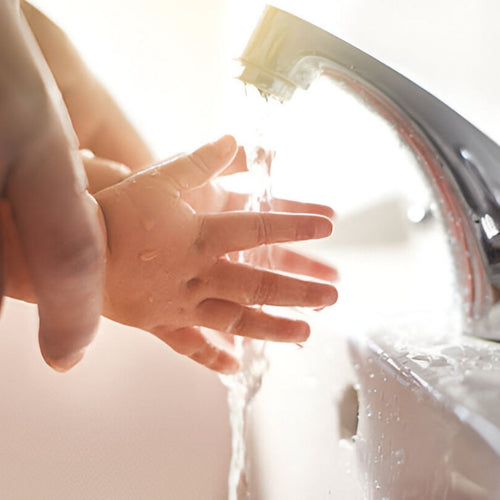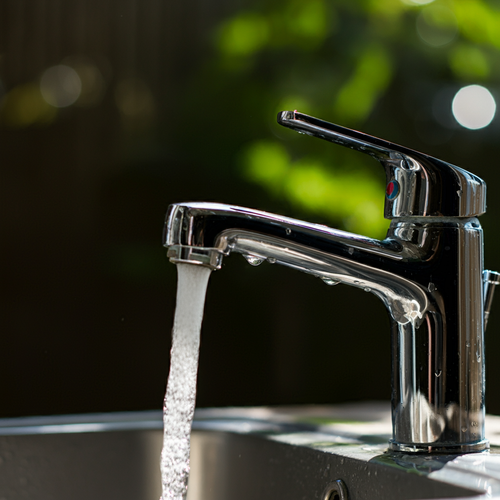Iron filters for well water work by oxidizing dissolved iron (ferrous iron) and converting it into solid particles (ferric iron). These particles are then trapped and filtered out, leaving you with clean, iron-free water. Many homes with well water systems experience issues with high iron content. This can cause staining, unpleasant taste and odor, and even damage appliances. Iron filters provide an effective solution to these problems. At SoftPro Water Systems, we specialize in providing high-efficiency water treatment solutions, including a variety of iron filters to meet your specific needs.

Understanding Iron in Well Water
If you have a well, you might be familiar with the telltale signs of iron in your water: rusty stains on your sinks and laundry, a metallic taste, or even reddish-brown water coming directly from the tap. But why is iron such a problem?
Why is Iron a Problem?
High levels of iron in well water can lead to a number of issues:
- Stains: Iron causes unsightly reddish-brown stains on plumbing fixtures, laundry, and even dishes. According to the Water Quality Association (WQA), "iron is one of the most common water quality problems in the United States, affecting millions of households."
- Taste and Odor: Dissolved iron can give water an unpleasant metallic taste and odor, making it less appealing for drinking and cooking. "Iron in water can impart a bitter, metallic taste that many find objectionable," states the WQA.
- Appliance Damage: Over time, iron can build up in appliances like water heaters and washing machines, reducing their efficiency and lifespan. A study by the National Rural Water Association found that "iron buildup can significantly reduce the efficiency of water heaters, leading to increased energy costs and premature failure."
- Health Concerns: While iron itself is an essential mineral, high levels in drinking water can be a concern for some individuals, especially those with hemochromatosis (a condition that causes iron overload). The Environmental Protection Agency (EPA) has set a secondary standard of 0.3 milligrams per liter (mg/L) for iron in drinking water.
Types of Iron
To understand how iron filters work, it's important to know the different forms of iron found in well water:
- Ferrous Iron (Dissolved Iron): This is the most common form of iron in well water. It is dissolved in the water and is not visible to the naked eye. Water may appear clear when first drawn, but after exposure to air, the ferrous iron oxidizes and turns rusty. For example, you might notice that a glass of water left sitting on the counter develops a reddish-brown tint over time.
- Ferric Iron (Oxidized Iron): Ferric iron is the solid, insoluble form of iron that causes the reddish-brown color in water. It is often visible as particles or sediment. If your water comes out of the tap with a rusty color, you likely have ferric iron in your water supply.
- Iron Bacteria: These are microorganisms that feed on iron and can cause a slimy buildup in pipes and plumbing fixtures. They can also produce an unpleasant odor. Iron bacteria are often associated with iron problems in well water.
How Iron Filters Work
Iron filters remove iron from well water through a multi-step process:
1. Oxidation
The first step is to oxidize the dissolved ferrous iron, converting it into solid ferric iron. This can be achieved through several methods:
- Air Injection: Introducing air into the water causes the ferrous iron to oxidize. This is often done using a venturi, a device that creates a pressure difference to draw air into the water stream.
- Chlorine Injection: Adding chlorine to the water also oxidizes ferrous iron. This method is often used in conjunction with other filtration methods.
- Manganese Greensand: This is a special filter media that acts as both an oxidizing agent and a filter. It contains manganese dioxide, which oxidizes ferrous iron and then traps the ferric iron particles.
2. Filtration
Once the iron has been oxidized, it needs to be filtered out of the water. This is typically done using one of the following filter media:
- Birm: This is a granular filter media that is specifically designed for iron removal. It acts as a catalyst, speeding up the oxidation process and filtering out the ferric iron particles.
- Manganese Greensand: As mentioned earlier, manganese greensand can both oxidize and filter iron. It is effective at removing both iron and manganese from well water.
- Other Media: Other filter media, such as catalytic carbon or zeolite, can also be used to remove iron, depending on the specific water conditions.

3. Backwashing
Over time, the filter media will become clogged with iron particles. To maintain the efficiency of the iron filter, it needs to be backwashed regularly. Backwashing involves reversing the flow of water through the filter to flush out the trapped iron and other contaminants.
Types of Iron Filters for Well Water
There are several types of iron filters available, each with its own advantages and disadvantages:
Oxidizing Filters
Oxidizing filters use an oxidizing agent, such as air or chlorine, to convert ferrous iron to ferric iron. They are effective at removing high levels of iron and can also remove other contaminants like hydrogen sulfide (which causes a rotten egg odor).
- Pros: High iron removal capacity, can remove other contaminants.
- Cons: May require more maintenance, can be more expensive than other types.
Example: An air injection oxidizing filter, like those offered by Pelican Water Systems, uses a venturi to introduce air into the water, oxidizing the iron.
Manganese Greensand Filters
Manganese greensand filters use a special filter media that acts as both an oxidizing agent and a filter. They are effective at removing both iron and manganese from well water.
- Pros: Effective at removing both iron and manganese, requires less maintenance than oxidizing filters.
- Cons: Can be more expensive than other types, may not be as effective at removing very high levels of iron.
Example: "Manganese greensand filters are a popular choice for well water treatment due to their ability to remove both iron and manganese," according to a study published in the Journal of Environmental Engineering.
Other Filter Types
Other types of iron filters include:
- Catalytic Carbon Filters: These filters use a special type of activated carbon that acts as a catalyst to oxidize ferrous iron.
- Zeolite Filters: These filters use a natural mineral called zeolite to remove iron and other contaminants.
What It's Not: It's important to note that iron filters are different from water softeners. While both systems improve water quality, they target different problems. Iron filters remove iron, while water softeners remove minerals like calcium and magnesium that cause hard water.
Choosing the Right Iron Filter
Selecting the right iron filter for your home depends on several factors:
- Water flow rate (GPM): This is the amount of water that flows through your pipes per minute. It's important to choose a filter that can handle your home's water demand.
- Iron concentration (ppm): A water test will determine the level of iron in your water. This will help you choose a filter with the appropriate capacity.
- Types of iron present: Knowing whether you have ferrous iron, ferric iron, or iron bacteria will help you select the most effective filter type.
- Presence of other contaminants: If your water contains other contaminants like manganese or sulfur, you'll need a filter that can address those issues as well.
- Budget and maintenance requirements: Consider your budget and how much time and effort you're willing to put into maintaining the filter.
Consulting with a Professional
We recommend getting a professional water test and consulting with a water treatment specialist to determine the best iron filter for your specific needs. Our team at SoftPro Water Systems can help you analyze your water test results and recommend the most appropriate and cost-effective solution.
Contact SoftPro Water Systems
Benefits of Using an Iron Filter
Installing an iron filter can significantly improve your home's water quality and provide numerous benefits:
- Improved Water Quality: Iron filters remove the unpleasant taste, odor, and discoloration caused by iron. "After installing an iron filter, our water tastes so much better! We no longer have to worry about the metallic taste or rusty stains," says a satisfied SoftPro customer.
- Protection of Appliances: By removing iron, you can protect your appliances from damage and extend their lifespan. The Water Quality Research Foundation reports that "iron buildup can reduce the efficiency of water heaters by up to 25%, leading to higher energy bills."
- Healthier Home Environment: By removing iron bacteria, you can improve the overall health and safety of your home's water supply. A study published in the journal Applied and Environmental Microbiology found that "iron bacteria can contribute to the formation of biofilms in plumbing systems, which can harbor other harmful bacteria."
- Increased Property Value: Investing in a well water iron filter can increase the value of your property by improving the quality and appeal of your water supply.
Maintaining Your Iron Filter
Proper maintenance is essential to ensure the longevity and effectiveness of your iron filter.
Regular Backwashing
Backwashing is the most important maintenance task for any iron filter. It involves reversing the flow of water through the filter to flush out the trapped iron and other contaminants. The frequency of backwashing depends on the type of filter and the level of iron in your water, but it is typically recommended to backwash at least once a month.
To backwash your iron filter:
- Turn off the water supply to the filter.
- Initiate the backwash cycle according to the manufacturer's instructions. This usually involves turning a valve or pressing a button on the control panel.
- Allow the backwash cycle to run for the recommended amount of time.
- Turn the water supply back on and rinse the filter until the water runs clear.
Other Maintenance Tasks
In addition to backwashing, you may need to perform other maintenance tasks, such as:
- Media Replacement: The filter media will eventually need to be replaced, typically every 3-5 years, depending on the type of media and water conditions.
- Regeneration: Some iron filters, such as those using manganese greensand, require periodic regeneration with potassium permanganate to maintain their oxidizing capacity.
Example: Our Smart Home+ iron filters offer automatic backwashing and notifications for media replacement, making maintenance a breeze.
Addressing Common Concerns
Here are some common concerns about iron filters and how to address them:
Low Water Pressure
Some homeowners worry that installing an iron filter will reduce their water pressure. While it's true that any type of filter can cause a slight pressure drop, this is usually minimal with properly sized and maintained iron filters. If you experience a significant pressure drop, it could indicate a problem with the filter or your plumbing system.
Solutions:
- Ensure proper filter sizing: Make sure the filter is sized correctly for your home's water flow rate.
- Check for clogs: Inspect the filter and plumbing for any clogs or restrictions.
- Consider a larger filter: If your water demand is high, you may need a larger filter with a higher flow rate capacity.
Filter Inefficiency
If you notice that your iron filter is not removing iron effectively, there could be several reasons:
- Clogged filter media: The filter media may be clogged with iron or other contaminants. Backwashing the filter should resolve this issue.
- Incorrect filter type: The filter may not be the right type for the type of iron in your water. For example, an oxidizing filter may not be effective at removing iron bacteria.
- High iron levels: The iron concentration in your water may be higher than the filter's capacity. You may need a larger filter or a different type of filter.
Troubleshooting Tips:
- Check the backwash cycle: Make sure the backwash cycle is running properly and that the filter media is being cleaned effectively.
- Test your water: Have your water tested to determine the current iron levels and other contaminants.
- Consult with a professional: If you're unable to resolve the issue, contact a water treatment specialist for assistance.
Cost
The cost of iron filters varies depending on the type of filter, size, and features. While the upfront cost can be a consideration, it's important to weigh it against the long-term benefits of clean, iron-free water.
Cost Considerations:
- Filter type: Oxidizing filters and manganese greensand filters tend to be more expensive than other types.
- Installation: Professional installation may add to the overall cost.
- Maintenance: Factor in the cost of replacement filter media and other maintenance tasks.
Financing Options: At SoftPro, we offer a variety of financing options to make iron filtration affordable for everyone.
Case Study: The Smiths' Rusty Water Solution
The Smith family in rural Wisconsin had struggled with rusty well water for years. Their water had high levels of ferric iron, causing stains on their fixtures and laundry. They also noticed a metallic taste in their drinking water. After consulting with SoftPro Water Systems, they decided to install a manganese greensand filter.
"We were amazed at the difference the iron filter made," says Mrs. Smith. "Our water is now crystal clear, and the stains are gone. We can finally enjoy clean, fresh-tasting water without worry."
Expert Insight: The Importance of Water Testing
"Many homeowners don't realize the importance of regular water testing," says John, a certified water treatment specialist with over 20 years of experience. "Water quality can change over time, and testing helps identify any potential problems, including high iron levels. This allows us to recommend the most effective water treatment solutions for each individual home."
Enjoying the Benefits of Clean Water
Dealing with iron in your well water can be frustrating, but with the right iron filter, you can enjoy the benefits of clean, clear, and healthy water. Iron filters effectively remove iron through a process of oxidation and filtration, protecting your home and appliances from the damaging effects of iron. By understanding the different types of iron filters and choosing the right one for your needs, you can ensure a reliable supply of high-quality water for your family.
Key Takeaways:
- Iron in well water can cause stains, taste and odor problems, appliance damage, and potential health concerns.
- Iron filters work by oxidizing dissolved iron and filtering out the solid particles.
- Different types of iron filters are available, including oxidizing filters, manganese greensand filters, and others.
- Choosing the right iron filter depends on factors like water flow rate, iron concentration, and types of iron present.
- Regular maintenance, including backwashing, is essential for optimal filter performance.
At SoftPro Water Systems, we are committed to providing our customers with the best water treatment solutions. Our team of experts can help you select the right iron filter for your home and ensure that you have access to clean, healthy water for years to come.
Ready to Improve Your Water Quality?
Get in touch with us today for a free water analysis and consultation. We'll help you find the perfect iron filter to meet your needs and budget.


















![Aldex Premium 10% Cross Link Resin for Water Softener [High Capacity]-SoftPro® Water Systems](http://www.softprowatersystems.com/cdn/shop/files/Aldex_10_Cross_Link_Resin_Premium_High_Capacity_for_Water_Softener_600x.jpg?v=1735853599)




















